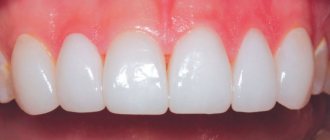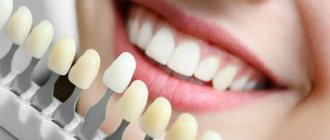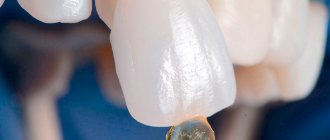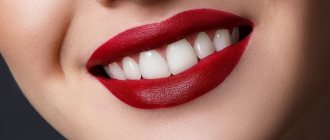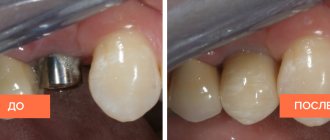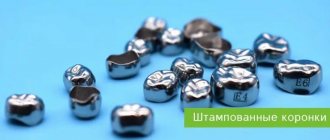Author of the article:
Anastasia Vorontsova
Photo: Computer modeling method
To install veneers, you will need to visit the dental clinic at least twice.
At the first visit, the doctor will prepare the tooth for installation of the onlay, take an impression, select the required color, depending on the color of the patient’s other teeth, and install a temporary veneer.
After one to two weeks, the patient will need a second visit to the dentist, during which the doctor will try on the manufactured veneer and fix it on the tooth.
Tooth color determination
Color selection must be carried out according to the recommendations given in the relevant section.
It is preferable to do this at the beginning of the visit, since it is possible to focus on the color of the tooth that has not yet been prepared (if the color has not changed) and the tooth is naturally moisturized. When drying from prolonged opening of the mouth, especially when using a rubber dam, the teeth become lighter and more dull, which can lead to errors in color selection. It is important to determine the color of the tooth based on the shade that the dental technician will work with (in the case of laboratory production). No translation from one colorway to another (for example, from Vitapan to Chromascop) is accurate, because each colorway has unique, non-repeating colors.
Indications for the use of veneers
Indications for the use of veneers
- Changes in tooth color (discoloration);
- Tooth surface defects – stained cracks, non-carious lesions extending beyond the middle of the vestibular surface;
- The presence of gaps between teeth with a sufficient area of remaining healthy enamel and refusal of orthodontic treatment;
- Dental trauma;
- Abrasion along the cutting edge.
Preprint
A preliminary impression is necessary to make a temporary veneer.
If the shape of the tooth is intact or slightly changed, then this impression can be used for the clinical fabrication of a temporary restoration, and then it is enough to take it with a partial tray.
If a laboratory is involved in making a temporary veneer, it is necessary to take an impression from the entire dentition, as well as a second impression from the antagonist dentition.
For preliminary impressions, alginate masses are most often used, since they allow better brightening of the cervical area in one step or more, and are economical.
During storage, the alginate impression must be placed in a tightly closed plastic bag without adding anything to it. Such storage is preferable to storage in water, since it will prevent the impression not only from excessive shrinkage, but also from the occurrence of porosity as a result of leaching of mass particles. It is worth noting that impressions made from modern alginate materials, when properly stored, do not shrink within 100 hours.
Features of ceramic veneers
Ceramic veneers are one of the most popular dentures. This type of lining has a number of positive aspects. They are installed on the front teeth, but before you decide on this procedure, you should be examined by a doctor, as there are a number of contraindications.
Advantages of ceramic veneers:
- For installation, tooth removal is not required. This allows you to preserve the process of trophism of hard tissues.
- Ceramics is an environmentally friendly material.
- Ceramic products can last more than 10 years.
- Thanks to the light transmission properties, teeth covered with such plates look as natural as possible.
- Products can be installed on cutters.
- With proper care, the material does not lose its shine and does not turn yellow.
Ceramic veneers can be installed on both older and younger people. They are also given to patients who are allergic to other materials. An equally important advantage of ceramic dentures is that if there are defects, they can be easily replaced with new ones. To remove the plate, a laser is used or the cutting method is used with a diamond bur. Veneers can be attached to one tooth or to several at once. The number of products is chosen by the client himself.
Unfortunately, the installation of products cannot be carried out if there are crowns and bulk fillings on the outer part of the tooth. Also, the plates are not intended for attachment to artificial teeth.
Preparation
It is incorrect to assume that preparation for a veneer corresponds to preparation for a ceramic crown, but only from the vestibular side. Indeed, the shape is similar, but for a veneer the minimum preparation depth along the ledge can be only 0.6 mm, in contrast to the crown, which should be no thinner than 1.0 mm in this place. Along the cutting edge, the veneer should be no thinner than 1.0 mm, and the crown – 2.0 mm.
When preparing teeth for veneers, doctors often use special sets of burs. At a minimum, these kits include a marker bur, a basic preparation bur, and a finishing bur.
A marker bur can be in the form of a wheel-shaped bur or consists of disks of a certain diameter strung on an axis at regular intervals. This bur is used to mark the preparation depth. And then, with the main bur, the hard tissues of the tooth are ground down to the bottom of the resulting marker grooves. Preparation without the use of marker burs is acceptable, but their use allows you to accurately calculate the depth of preparation, taking into account the small thickness of the veneers, and is strongly recommended for novice doctors.
The main preparation is most often done with a cone-shaped bur with a rounded top. In this case, the bur is placed parallel to the axis of the tooth, and the tip of the bur is held at the level of the future ledge, repeating the contours of the gum as it moves. Particular attention is paid to the transition from the vestibular surface to the contact surface. If the natural contact point is not broken, then the preparation is carried out in such a way as not to affect it.
There are two main options for preparation in the area of the incisal edge (or tip of the canine) - with and without overlap. The choice depends on the occlusal relationship of the patient's teeth and the doctor's preferences. The main thing is that the transition zone from the veneer to the tooth tissue does not fall into occlusal contact in the central occlusion, which is checked using articulation paper. Therefore, preparation with overlapping of the cutting edge, in which a ledge is formed on the oral side, is preferable.
The preparation is completed by smoothing out sharp transitions and finishing the surface. For these purposes, a bur of the same shape as the bur for basic preparation, but fine-grained or carbide, is best suited. Such smoothing is necessary not only for a more accurate representation of the relief in the print and, accordingly, on the model, but also to prevent chipping of the ceramic, since stress is concentrated in sharp transitions.
Installation steps
Photo: Veneers on a plaster model
- Cleaning the tooth surface from plaque. Products that do not contain oils and fluoride are used.
- Selection of the required shade of filling material.
- Grinding of the front surface of the tooth with preliminary anesthesia. The required amount of enamel is removed from the surface of the tooth. The depth of enamel grinding depends on the thickness of the veneer overlay.
- Taking impressions. To take dental impressions, a special spoon is used, on which a special paste is applied, then the spoon is pressed against the teeth until the mass hardens.
- Based on the dental impressions obtained, a plaster model is cast in the laboratory to obtain an exact copy of the patient’s teeth.
- Making a veneer using a cast plaster model.
- After the doctor has prepared the teeth, a temporary veneer is made directly in the office.
- Trying on the finished veneer after its manufacture. If necessary, adjustments are made, deficiencies are eliminated, and the bite is checked.
- The tooth and veneer are washed under running water and dried with air. Then, to increase the strength of fixation of the plate to the tooth, the doctor etches the enamel with a special gel. Only after this is the veneer fixed to the tooth using special cement.
Cleaning teeth from plaque
Photo: Cleaning teeth from plaque before installing veneers.
It is a must when carrying out any types of restorations.
- Cleansing is performed with a special paste that gently cleanses the tooth of plaque and plaque.
- The dentist applies the paste to a rotating standard polishing disc or brush and cleans.
- To prevent heating, the paste is taken in large quantities.
- In this case, saliva is a kind of saliva ejector.
- After treatment with the paste, the tooth is thoroughly rinsed with water.
Ignoring this procedure leads to a fairly rapid formation of plaque around the lining and pigmented border.
Selecting the shade of filling material
With the patient in a sitting position, the color of the filling material is selected in natural light.
The tooth and reference should be wet when choosing the color, which gives them a natural look.
The choice of shade should be made in natural light.
Tools and equipment for tooth preparation
High-quality grinding of a tooth before covering it with veneer requires the use of modern, highly functional dental equipment.
- The preparation unit must have water-air cooling, a tip washing system, a fiber optic device, a scaler, a 270° rotation of the control panel around the chair, an air-water gun and a control unit for three tips.
- The spittoon must be equipped with an air vacuum group: a dust and saliva ejector, and a built-in clean water system.
- The presence of a lighting device - a reflector, creating a uniform illuminated field with clear boundaries.
- Equipping the dental chair with a silent electromechanical lift makes it possible to treat the patient in a lying position with four hands.
Working impression and occlusion determination
When making a veneer in a laboratory in a clinic, it is necessary to take an impression from the dentition, including the prepared tooth, an auxiliary impression from the antagonist dentition, and determine the patient’s usual occlusion.
Precision polyvinylsiloxane (silicon-A) materials are best suited for the working impression. For preparations with a shoulder at or below the gingival level, gingival retraction is performed and a two-layer impression is obtained using a one-step or two-step technique, depending on preference.
For an auxiliary impression, alginate mass is used. And to register occlusion, special silicones are used again. The advantage of these special materials over waxes is that they are more rigid and allow the application of registration material after closure of the dentition and control of occlusion. The base layer of the impression mass, as well as the base wax, are not suitable for recording occlusion, since they are not rigid enough and can lead to significant errors.
Materials
Veneers are made from different materials, with ceramic and composite materials being the most popular.
The choice of material is one of the most important stages in the manufacture of veneers.
Modern composite materials are used to manufacture structures using the direct method.
In this case, it is best to give preference to materials that are the most reliable: not subject to abrasion, color-fast, have a wide range of colors, and are well polished.
Manufacturing/fixation of temporary veneer
A temporary veneer is made from a preliminary impression or template made in a dental laboratory. To do this, the undercuts in the impression are cut off and material for temporary restorations is added to it. After this, the impression along with the material is brought into the oral cavity and pressed out. After hardening, the restoration is removed from the impression, processed with cutters and polished.
Sometimes a temporary veneer is made like a direct veneer from a composite filling material, but always without the use of adhesive systems so that it can be completely removed.
Before fixing the provisional veneer, it is recommended to treat the tooth stump with a desensitizer (for example, “BV” material). This is necessary to reduce the risk of increased tooth sensitivity. The principle of operation of these agents is to seal the tubules of exposed dentin. In this case, it is precisely desensitizers that should be used, and not, for example, composite adhesives, in contrast to which they practically do not create a film on the dentin surface, without compromising the accuracy of the fit, and at the same time, which is very important, they do not impair the strength of subsequent adhesive fixation. Therefore, desensitizers can be used repeatedly, both before taking impressions and after, without fear of breaking the marginal seal.
For temporary fixation, eugenol-free temporary cements, such as Systemp, should be used. link, because they do not cause inhibition of adhesive systems during permanent fixation. In difficult cases, fixation is carried out using a bond, spot etching or, without etching the surface of the stump at all.
Manufacturing and installation
Veneers go through the following stages of manufacturing and installation:
- The initial patient appointment usually includes taking an anamnesis, clarifying complaints, examination, and instrumental examination of the teeth.
- The condition of the gums and plaque is assessed.
- If necessary, X-ray and laboratory tests are performed.
The next step is planning, which involves researching factors such as:
- Gender, age, character of the patient.
- The smile and facial shape are assessed.
- The shape of the line of the gingival margin of the patient’s anterior group of teeth is studied.
- The individual characteristics of the tooth, shape, position, location of contact points, and the direction of the tooth axes are assessed.
- The initial parameters of the restored and intact teeth are measured.
- The size of the veneers is predicted and calculated.
- Demonstration of future restoration on a computer monitor.
Before starting the restoration, it is necessary to carry out professional teeth cleaning and only after that select the color of the veneers being made.
Fitting
At the fitting stage, the marginal fit, occlusal contacts, shape and color of the veneer are checked.
The accuracy of the marginal fit is assessed using a corrective layer of impression mass. In places where the mass is pressed through, the veneer is ground off with diamond burs.
Occlusal correction is then made as far as possible. Due to insufficient fixation of the veneer during fitting, the final occlusal correction can be carried out after cementation.
The shape of the veneer is agreed upon with the patients. Corrections are made if necessary.
The color of the veneer is assessed by placing it on the stump using special glycerin try-in gels. The color of the gel fully matches the color of the fixing material, therefore, based on it, you can accurately select the one you need from the assortment of adhesive cement. In this case, inaccurate color matching can be corrected.
Layer-by-layer method
In this method, plates are made from platinum foil, whose thickness is 0.020-0.025 millimeters.
The foil is pressed around the prepared tooth on a plaster model. The specialist applies ceramic mass to the model and fires it. The foil holds the ceramics during the firing process, which prevents possible distortion and loss of the desired shape. The model is then sanded and finishing touches are made so that the veneer can be seated on the intended tooth without any problems. This technique is economical because it does not require the use of expensive platinum foil. Therefore, manufacturing the structure will not cost a lot of money.
What are veneers and what are they made from?
Veneers are ceramic plates installed on the outer surface of teeth in order to restore (create) the aesthetics of a smile. This restoration method refers to microprosthetics. If the teeth are miniature and there are gaps between them, then dentures can be installed without turning, only by treating the enamel to improve adhesion. In all other cases, the teeth along the front and side surfaces need a little gentle grinding. Therefore, subsequently removing the veneer and leaving the tooth “as is” will not work. You will need to either fix a new veneer or install a full-fledged prosthesis - a crown.
The thickness of the microprosthesis is 0.5 - 0.7 mm. When installed correctly, it fits tightly to the surface of the dental element and does not allow pathogenic microflora to penetrate there. Veneers are generally made from a durable ceramic alloy. It is hypoallergenic and biocompatible with body tissues. Sometimes plates are made of composite or zirconium, but ceramics, according to experts, has more reliable strength characteristics and is aesthetically identical to natural teeth.
Note: the color and shape of the veneers are selected using a special computer program using real photographs of the patient. This allows you to see the result before the actual installation of the records.
Is it worth getting veneers on your teeth?
In the modern world, every second person wonders whether it is worth getting veneers?
Veneers have many advantages over other types of dental restoration. First of all, they are durable. Your snow-white smile will last for many years, which will make your life much easier. This is the fastest way to correct aesthetic problems, without wearing braces.
If you want a snow-white smile that will look natural and last for many years, then veneers are exactly what you are looking for. All that's left is to find good dentists. Our clinic will help you with this!
SmileStudio employs only highly qualified specialists who do their work quickly, efficiently and at the best prices! Trust our specialists and you will get a perfect smile for many years.
Caring for porcelain veneers
Subject to proper hygiene and periodic dental examinations, veneers can last for more than ten years. The service life of veneers depends on proper care.
Teeth with porcelain veneers should be thoroughly cleaned daily with a toothbrush and floss. Compliance with hygiene rules minimizes the accumulation of plaque and the risk of caries. Veneers, of course, are not subject to caries, but caries can occur in those parts of the tooth that are not covered by the veneer.
Porcelain veneers are designed to improve the appearance of a tooth and cannot withstand significant stress or force. To eliminate excessive force, you need to wean yourself from the habit of biting your nails, opening bottles with your teeth, etc. These forces can cause the veneer to break or become dislodged.
A beautiful white-toothed smile attracts attention and makes a person even more beautiful. Contact a specialist - we will help you!

